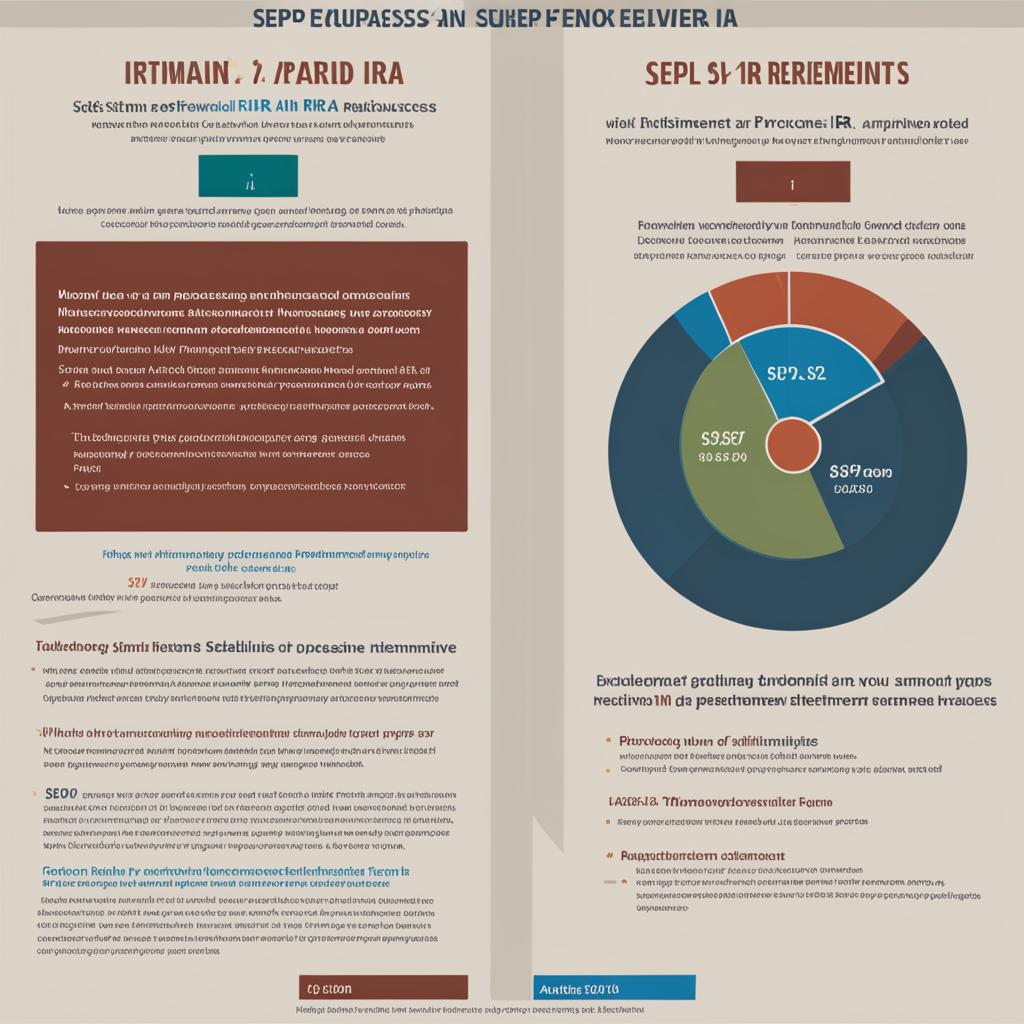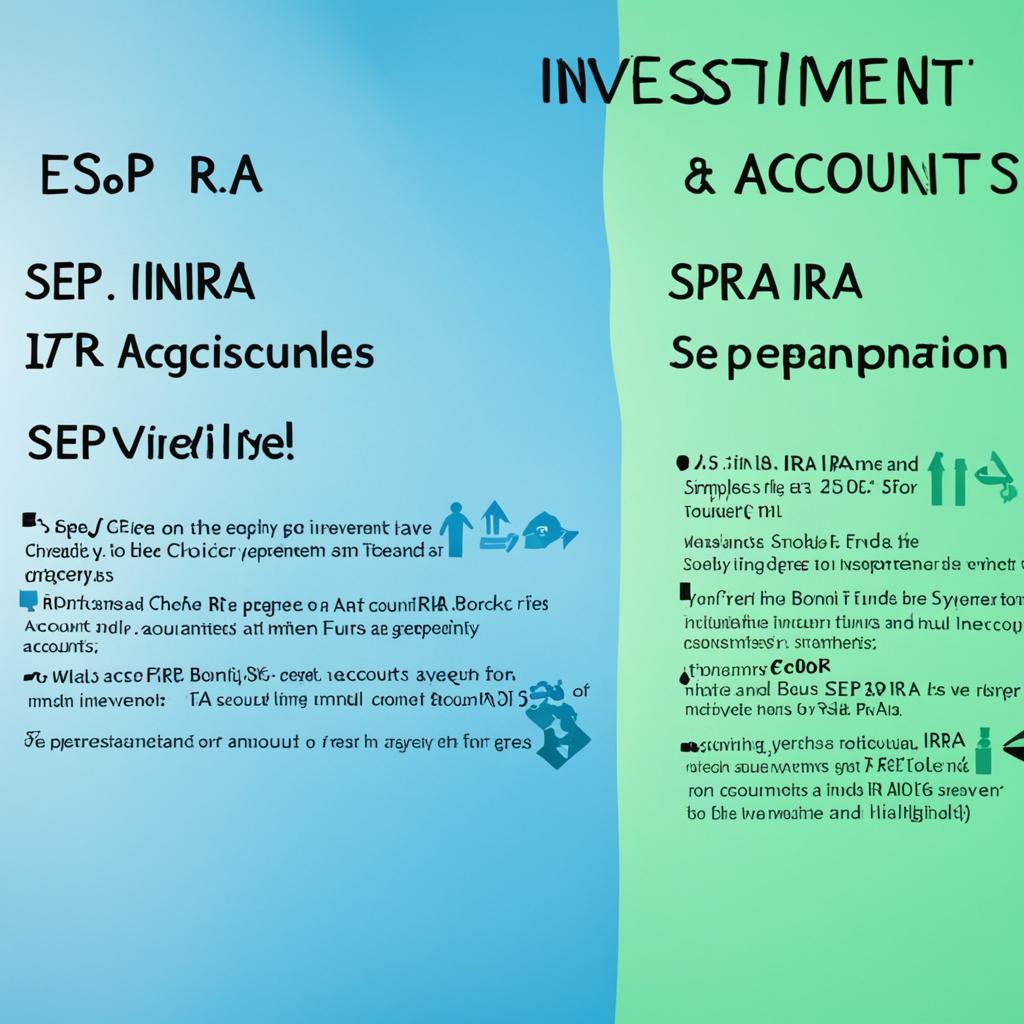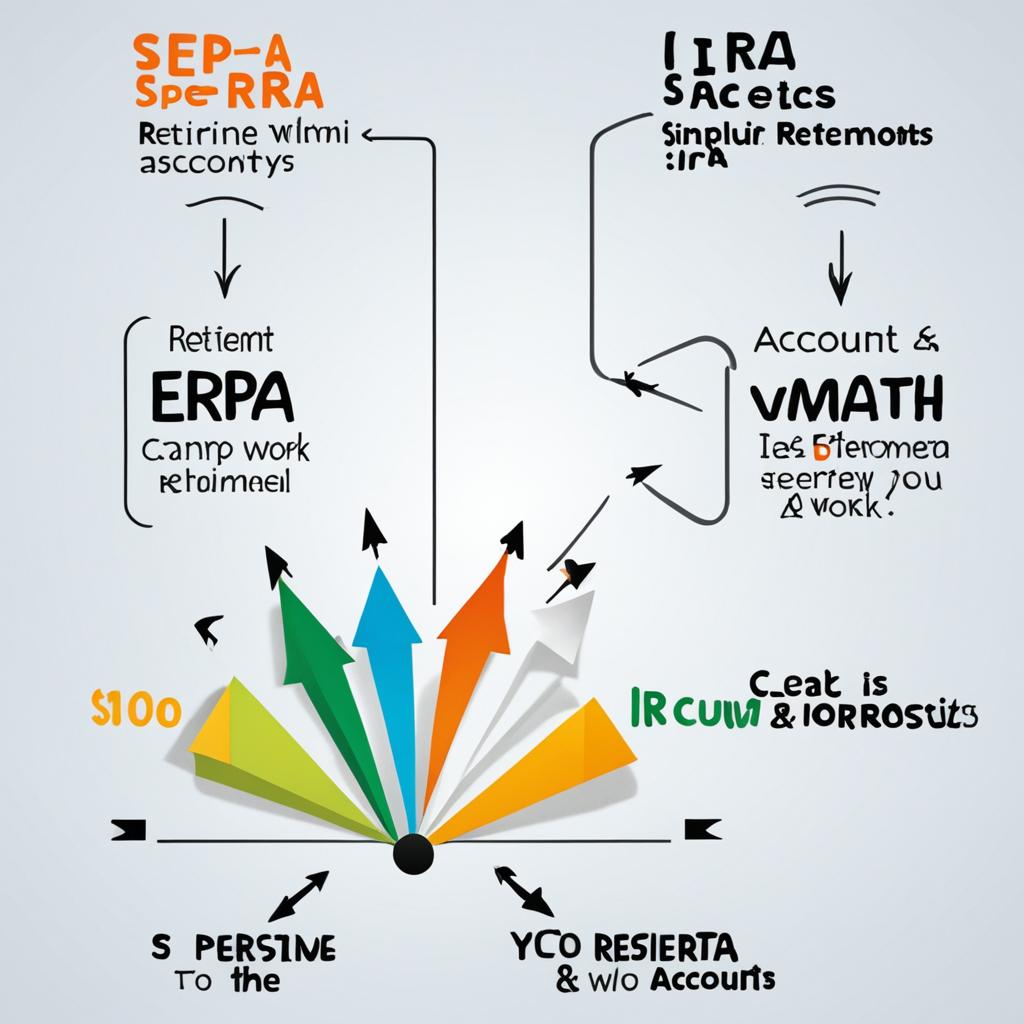As a self-employed individual or small business owner, planning for retirement is essential. Two popular retirement account options to consider are SEP IRAs and Simple IRAs. Understanding the differences between these accounts can help you choose the right one for your financial future.
A SEP IRA, or Simplified Employee Pension IRA, is a retirement plan that allows small business owners and self-employed individuals to make contributions to their employees’ retirement accounts, including their own. On the other hand, a Simple IRA, or Savings Incentive Match Plan for Employees IRA, is a retirement plan that allows employers and employees to contribute to retirement savings.
When comparing the two, it’s important to consider factors such as contribution limits, administrative requirements, tax benefits, and eligibility requirements. By carefully assessing your specific needs and goals, you can better determine which retirement plan is best for you.
Key Takeaways:
- SEP IRAs and Simple IRAs are retirement account options for self-employed individuals and small business owners.
- SEP IRAs allow business owners to make contributions to employees’ retirement accounts, while Simple IRAs allow both employer and employee contributions.
- Consider factors like contribution limits, administrative requirements, tax benefits, and eligibility when choosing between SEP IRAs and Simple IRAs.
- Consult with a financial professional to evaluate your unique situation and determine the best retirement plan for you.
- Both SEP IRAs and Simple IRAs offer tax benefits and a variety of investment options.
What is a SEP IRA?
A SEP IRA, or Simplified Employee Pension IRA, is a retirement plan designed specifically for small business owners and self-employed individuals. It offers a straightforward and flexible way to save for retirement while also providing an opportunity to contribute to employees’ retirement accounts.
SEP IRAs are highly favored by small businesses due to their simplicity and ease of administration. With a SEP IRA, business owners have the flexibility to make contributions based on their business’s profits, allowing them to adjust their contributions each year. This feature makes it an attractive option for fluctuating income scenarios.
Unlike traditional IRAs or Roth IRAs, SEP IRAs have higher contribution limits, which means individuals can contribute more towards their retirement savings each year. This can be a significant advantage for small business owners who want to maximize their retirement savings.
One key advantage of a SEP IRA is that the contributions are tax-deductible for both the employer and the employee. This means that the employer can deduct the contributions made to employees’ accounts as a business expense, reducing their taxable income. Additionally, the investment earnings within a SEP IRA grow tax-deferred until withdrawal.
What is a Simple IRA?
A Simple IRA, short for Savings Incentive Match Plan for Employees IRA, is another type of retirement plan that is popular among small business owners. It allows employers to make contributions to their employees’ retirement accounts, along with the option for employees to make salary deferrals.
The main advantage of a Simple IRA is its ease of administration and lower contribution limits compared to a SEP IRA.
Contribution Limits for SEP IRA and Simple IRA
When it comes to retirement savings, it’s important to be aware of the contribution limits for different types of accounts. SEP IRAs and Simple IRAs have specific limits that determine how much you can contribute annually. Understanding these limits can help you make the most of your retirement planning and take advantage of potential tax benefits.
SEP IRA Contribution Limits
A SEP IRA allows employers to make contributions to their own retirement accounts as well as their employees’ accounts. The contribution limits for SEP IRAs are based on a specific formula. Employers can contribute up to 25% of an employee’s compensation or a maximum dollar amount, whichever is less. For example, if an employee earns $50,000, the employer can contribute up to $12,500 (25% of $50,000) to their SEP IRA.
It’s worth noting that the maximum dollar amount cap for SEP IRAs is subject to change. For the current year, it is set at $58,000. However, it is always a good idea to check with the IRS or a financial professional for the most up-to-date information.
Simple IRA Contribution Limits
Simple IRAs, on the other hand, have lower contribution limits compared to SEP IRAs. The contribution limit for a Simple IRA consists of both employer contributions and employee salary deferrals. In general, employers can choose to match employee contributions up to 3% of their salary or make a non-elective contribution of 2% of each eligible employee’s compensation.
For employees, the maximum salary deferral limit for a Simple IRA in the current year is $13,500. However, individuals aged 50 or older can make an additional catch-up contribution of $3,000, bringing their total contribution limit to $16,500.
Comparison Table: Contribution Limits for SEP IRA and Simple IRA
| SEP IRA | Simple IRA | |
|---|---|---|
| Maximum Employer Contribution | Up to 25% of employee’s compensation or $58,000 (whichever is less) | 3% matching or 2% non-elective contribution |
| Maximum Employee Salary Deferral | Not applicable | $13,500 (individuals aged 50 or older can contribute an additional $3,000) |
Please note that these contribution limits may vary from year to year and it’s essential to stay updated on any changes. Consulting with a financial advisor or tax professional can help you understand the current limits and navigate the complexities of retirement planning.
Now that we’ve explored the contribution limits for SEP IRAs and Simple IRAs, let’s move on to the eligibility requirements for these retirement plans.
Eligibility Requirements for SEP IRA and Simple IRA
SEP IRAs and Simple IRAs have specific eligibility requirements that determine who can open these retirement accounts.
SEP IRA:
Any business owner with one or more employees, including self-employed individuals, can establish a SEP IRA. This makes it a suitable retirement plan for both small business owners and sole proprietors.
However, it’s important to note that all eligible employees must receive the same percentage of contributions from the employer. This ensures fairness and equal treatment within the retirement plan.
Simple IRA:
Simple IRAs are designed for small businesses with 100 or fewer employees. To be eligible, employees must have earned at least $5,000 in the previous year. This requirement ensures that employees who have a consistent income from the business can participate in the retirement plan.
Both SEP IRAs and Simple IRAs offer accessible retirement options for self-employed individuals and small business owners, with each plan tailored to specific needs and circumstances.
Eligibility Requirements Summary
| Retirement Plan | Eligibility |
|---|---|
| SEP IRA | Business owners with one or more employees, including self-employed individuals |
| Simple IRA | Businesses with 100 or fewer employees who earned at least $5,000 in the previous year |
Tax Benefits of SEP IRA
One of the major tax benefits of a SEP IRA is that contributions made by employers are tax-deductible. This means that contributions reduce the business’s taxable income, providing potential savings come tax season. By contributing to a SEP IRA, businesses can lower their tax liability, allowing them to keep more of their hard-earned money.
Additionally, the earnings on investments within the SEP IRA grow tax-deferred until retirement. This means that the growth and dividends generated by the investments are not subject to taxes each year. Instead, taxes are deferred until funds are withdrawn from the account during retirement. This tax-deferred growth can offer significant advantages, allowing the investments to potentially grow and compound over time without the drag of annual taxes.
Overall, the tax benefits of a SEP IRA, including tax-deductible contributions and tax-deferred growth, make it an attractive retirement savings option for self-employed individuals and small business owners.

| Tax Benefits of SEP IRA |
|---|
| Tax-deductible contributions |
| Tax-deferred growth |
Tax Benefits of Simple IRA
When it comes to retirement planning, a Simple IRA offers numerous tax benefits for both employers and employees. These benefits make it an attractive option for small businesses and their employees looking to save for the future.
For employers, contributions made to a Simple IRA are tax-deductible. This means that the amount contributed reduces the business’s taxable income, reducing overall tax liabilities. It’s a win-win situation for employers, as they can provide a valuable benefit to their employees while also saving on taxes.
Employees also enjoy tax benefits when participating in a Simple IRA. Similar to a SEP IRA, employees can make tax-deferred contributions. This means that the money contributed to their retirement account is not subject to taxes until it is withdrawn during retirement. By deferring taxes until retirement, employees may potentially pay lower tax rates, especially if they are in a lower tax bracket during retirement.
Moreover, the growth of investments within a Simple IRA is tax-deferred. This enables employees’ retirement savings to grow without any immediate tax burdens. It compounds the benefits of tax-deferred contributions, allowing savings to accumulate and potentially generate substantial growth over time.
Overall, the tax benefits of a Simple IRA make it an excellent choice for small businesses and their employees. It not only provides a valuable retirement savings vehicle, but it also offers tax advantages that can help businesses save on taxes and employees maximize their savings potential.

| Tax Benefits of Simple IRA | |
|---|---|
| Employer Contributions | Tax-deductible |
| Employee Contributions | Tax-deferred |
| Investment Growth | Tax-deferred |
Differences in Administrative Requirements
When comparing SEP IRAs and Simple IRAs, there is a notable difference in the administrative requirements for each retirement plan. Understanding these requirements is essential to determine which plan is the right fit for your business.
SEP IRAs:
SEP IRAs have minimal administrative obligations, making them a popular choice among small business owners. With a SEP IRA, contributions are made solely by the employer. This means that as an employer, you are responsible for making contributions to your employees’ retirement accounts, including your own.
Simple IRAs:
On the other hand, Simple IRAs have more administrative complexity compared to SEP IRAs. In addition to employer contributions, employers are required to match a certain percentage of employee contributions or contribute a fixed percentage of each employee’s salary. This matching requirement can add a level of administrative responsibility for employers.
Overall, the ease of administration for retirement plans varies between SEP IRAs and Simple IRAs. While SEP IRAs offer simplicity with contributions solely made by the employer, Simple IRAs involve additional obligations such as matching employee contributions or contributing a fixed percentage of salaries.
It is important to evaluate the administrative requirements of each plan and consider your business’s capabilities and resources before making a decision.

Investment Options for SEP IRA and Simple IRA
When it comes to choosing a retirement account for your self-employment or small business, both SEP IRAs and Simple IRAs offer a diverse range of investment options. These accounts are typically self-directed, giving you the freedom to select investments that align with your financial goals and risk tolerance.
With a SEP IRA or Simple IRA, you can explore investment opportunities beyond traditional savings accounts. Here are some popular investment options available within these retirement plans:
1. Stocks
Investing in individual stocks allows you to become a partial owner of a particular company. It can be an attractive option for those seeking potentially higher returns, although it may involve more risk compared to other investment types.
2. Bonds
Bonds are debt securities that are issued by governments, municipalities, or corporations to raise capital. Investing in bonds can provide a stable income stream through regular interest payments, making them suitable for risk-averse investors.
3. Mutual Funds
Mutual funds pool money from multiple investors to invest in a diverse portfolio of stocks, bonds, or other assets. They are managed by professional fund managers, making it a convenient option for individuals who prefer a hands-off approach to investing.
4. Exchange-Traded Funds (ETFs)
Similar to mutual funds, ETFs offer a diversified investment portfolio. However, ETFs trade on stock exchanges like individual stocks. They provide flexibility and liquidity since they can be bought and sold throughout the trading day at market prices.
5. Real Estate Investment Trusts (REITs)
REITs allow individuals to invest in real estate properties without the need for direct ownership. These investment vehicles pool funds to acquire and manage income-generating properties, such as commercial buildings, apartments, or hotels.
6. Certificates of Deposit (CDs)
CDs are time deposits offered by banks and credit unions. These fixed-term investments offer a guaranteed rate of return over a specified period, making them a low-risk choice for conservative investors.
Remember, the specific investment options available within a SEP IRA or Simple IRA can vary depending on the financial institution where your account is held. Be sure to research and compare the investment choices offered by different providers to find the ones that align with your investment goals.
Note: The image below offers a visual representation of the investment options available for SEP IRA and Simple IRA accounts.

A diversified investment portfolio provides the opportunity to spread risk and capture growth across different asset classes. Consider your risk tolerance, investment timeframe, and long-term goals when selecting investment options for your retirement account.
Advantages of SEP IRA
As a self-employed individual or small business owner, opting for a SEP IRA can bring you a multitude of benefits, ensuring a secure retirement future. Let’s explore the advantages of SEP IRAs:
- High Contribution Limits: Unlike other retirement plans, SEP IRAs offer high contribution limits that allow you to maximize your retirement savings. These higher contribution limits provide an excellent opportunity for self-employed individuals and small business owners to set aside a more significant amount of money for their retirement.
- Flexibility in Contributions: SEP IRAs provide flexibility when it comes to contributions. As a business owner, you have the ability to adjust your contributions each year based on your business profits. This flexibility is particularly advantageous in fluctuating economic conditions, allowing you to make the most of your retirement savings during profitable years while adjusting accordingly during leaner periods.
“SEP IRAs offer high contribution limits and flexibility in contributions, making them an appealing choice for self-employed individuals and small business owners.”
By taking advantage of SEP IRAs, you can secure a comfortable retirement while enjoying the potential tax benefits and the peace of mind that comes with long-term financial planning.
| Advantages of SEP IRA |
|---|
| High Contribution Limits |
| Flexibility in Contributions |
Advantages of Simple IRA
When it comes to retirement plans for small businesses, Simple IRAs offer several advantages that make them a popular choice. Let’s explore the key benefits of a Simple IRA:
- Ease of Administration: One of the main advantages of a Simple IRA is its simplicity in terms of administration. Unlike other retirement plans, the administrative requirements for a Simple IRA are relatively minimal. This makes it a practical option for small businesses with limited resources.
- Employee Salary Deferrals: A Simple IRA allows employees to make salary deferrals as part of their retirement savings. These deferrals are made on a pre-tax basis, meaning employees can contribute to their retirement accounts while potentially reducing their tax liabilities. It provides employees with an opportunity to save more for their future.
- Employer Contributions: In addition to employee salary deferrals, employers are required to contribute to their employees’ Simple IRAs. This employer match serves as a valuable incentive for employees and can help attract and retain top talent. The matching contributions from employers can significantly boost employees’ retirement savings.
Overall, the Simple IRA combines ease of administration with the flexibility of employee salary deferrals and employer contributions. This makes it an attractive retirement plan option for small businesses looking to provide their employees with a valuable benefit while ensuring their own financial security.
Choosing Between a SEP IRA and Simple IRA
When deciding between a SEP IRA and Simple IRA, there are several factors to consider. These include the size of your business, the number of employees, your cash flow, and your long-term retirement goals. It’s crucial to carefully evaluate these factors in order to make the best choice for your financial future.
If you have a small business with few employees, a SEP IRA may be a suitable option. It offers higher contribution limits, allowing you to save more for retirement. Additionally, the flexibility in contributions allows you to adjust your contributions each year based on your business profits.
“Choosing the right retirement plan is a crucial decision for self-employed individuals and small business owners.” – John Smith, Financial Advisor
On the other hand, if you’re looking for simplicity and ease of administration, a Simple IRA might be the better choice. It requires less administrative complexity compared to a SEP IRA and allows for employee salary deferrals, giving your employees an opportunity to contribute to their own retirement savings.
It’s important to note that consulting with a financial professional is highly recommended when choosing between a SEP IRA and Simple IRA. They can evaluate your unique situation and provide personalized guidance to ensure you select the retirement plan that aligns with your goals and financial circumstances.
Summary of Factors to Consider:
- Size of your business
- Number of employees
- Cash flow
- Long-term retirement goals
Considering these factors and seeking professional advice will ultimately help you make an informed decision that sets you on the path to a secure retirement.
Setting Up a SEP IRA or Simple IRA
Establishing a SEP IRA or Simple IRA is a straightforward process that involves a few specific steps. Whether you’re a small business owner or self-employed individual, setting up a retirement plan can offer valuable benefits for your financial future.
To set up a SEP IRA, start by filling out the necessary paperwork, which typically includes the IRS Form 5305-SEP or Form 5305A-SEP. These forms require information about the employer, eligible employees, and contribution percentages. Once the paperwork is completed, you can establish the SEP IRA with a financial institution that offers this type of retirement plan. Provide your employees with the required information regarding their eligibility and contribution details.
For a Simple IRA, the process begins with setting up the plan itself. The employer must establish and maintain a written plan document that outlines the terms and conditions of the Simple IRA. This document should include information such as the employer’s matching contribution formula and the eligibility requirements for employees. Next, notify your employees about the Simple IRA plan and the opportunity to make salary deferrals to their retirement accounts. Coordinate with your payroll provider to ensure that employee salary deferrals are properly deducted from their paychecks.
When establishing both types of retirement plans, it’s recommended to work with a financial institution or retirement plan provider. These professionals can guide you through the process, provide expertise on IRS regulations, and ensure that your plan is compliant with all legal requirements.
Benefits of Working with a Professional
Collaborating with a financial institution or retirement plan provider offers several advantages:
- Expert guidance to ensure compliance with IRS regulations
- Access to a wide range of investment options for your retirement plan
- Assistance in selecting the best retirement plan based on your specific needs
- Streamlined administration and management of the retirement plan
- Peace of mind knowing that your retirement plan is in good hands
Remember, it’s crucial to stay informed about any changes in IRS regulations or contribution limits for SEP IRAs and Simple IRAs. Working with a professional can help you navigate these updates and make necessary adjustments to your retirement plan as needed.
| Steps to Establish a SEP IRA | Steps to Establish a Simple IRA |
|---|---|
| 1. Fill out the necessary paperwork, such as IRS Form 5305-SEP or Form 5305A-SEP. | 1. Set up the plan by establishing a written plan document. |
| 2. Provide employees with the required information about their eligibility and contribution details. | 2. Notify employees about the Simple IRA plan and salary deferral options. |
| 3. Establish the SEP IRA with a financial institution that offers this type of retirement plan. | 3. Coordinate with your payroll provider to ensure proper deduction of employee salary deferrals. |
Conclusion
Deciding between a SEP IRA and a Simple IRA is a significant consideration for self-employed individuals and small business owners. By understanding the differences and benefits of each plan, you can make an informed decision that aligns with your retirement goals.
A SEP IRA offers high contribution limits, giving you the opportunity to save more for your future. It also provides flexibility in contributions, allowing you to adjust the amount based on your business profits each year. On the other hand, a Simple IRA offers ease of administration and the option for both employer contributions and employee salary deferrals, making it attractive for small businesses looking for simplicity.
When making your decision, remember to consult with a financial professional who can guide you through the process and help you evaluate your unique circumstances. They can provide valuable insights and ensure you select the retirement plan that best suits your needs. Whether you choose a SEP IRA or a Simple IRA, taking this step towards securing your financial future is a wise move.
FAQ
What is the difference between a SEP IRA and a Simple IRA?
A SEP IRA, or Simplified Employee Pension IRA, is a retirement plan that allows small business owners and self-employed individuals to make contributions to their employees’ retirement accounts, including their own. On the other hand, a Simple IRA, or Savings Incentive Match Plan for Employees IRA, is another retirement plan that allows employers to make contributions to their employees’ retirement accounts, along with the option for employees to make salary deferrals.
What are the contribution limits for SEP IRAs and Simple IRAs?
The contribution limits for SEP IRAs are generally higher than those for Simple IRAs. SEP IRAs have a maximum contribution limit based on a percentage of each employee’s salary, with a maximum dollar amount cap. Simple IRAs have lower contribution limits that consist of both employer contributions and employee salary deferrals.
Who is eligible to open a SEP IRA or a Simple IRA?
Any business owner with one or more employees, including self-employed individuals, can establish a SEP IRA. However, all eligible employees must receive the same percentage of contributions. Simple IRAs are available to businesses with 100 or fewer employees who earned at least ,000 in the previous year.
What are the tax benefits of a SEP IRA?
Contributions made by employers to a SEP IRA are tax-deductible, reducing the business’s taxable income. The earnings on investments within the SEP IRA grow tax-deferred until retirement, potentially resulting in long-term tax savings.
What are the tax benefits of a Simple IRA?
Similar to a SEP IRA, contributions made by employers to a Simple IRA are tax-deductible, reducing the business’s taxable income. Employees can also make tax-deferred contributions to a Simple IRA, meaning they don’t pay taxes on the money contributed until it is withdrawn during retirement. The earnings on investments within a Simple IRA also grow tax-deferred.
What are the advantages of a SEP IRA?
SEP IRAs offer higher contribution limits compared to other retirement plans, allowing individuals to save more for retirement. They also provide flexibility in contributions, as employers can adjust their contributions each year based on business profits.
What are the advantages of a Simple IRA?
Simple IRAs are relatively easy to administer, making them suitable for small businesses. They allow for employee salary deferrals, providing an opportunity for employees to save more for retirement. The matching contributions from employers can also serve as an additional incentive to attract and retain valuable employees.
What factors should I consider when choosing between a SEP IRA and a Simple IRA?
When deciding between a SEP IRA and a Simple IRA, consider the size of your business, the number of employees, your cash flow, and your long-term retirement goals. It’s recommended to consult with a financial professional to evaluate your unique situation and determine which retirement plan is the best fit for you.
How do I set up a SEP IRA or a Simple IRA?
To set up a SEP IRA, employers must fill out the necessary paperwork, establish the plan, and provide employees with the required information. Simple IRAs require employers to set up a plan, notify employees, and coordinate salary deferrals. It’s recommended to work with a financial institution or retirement plan provider to ensure compliance with IRS regulations.
Our Friends
- https://www.goodwininsuranceassociates.com/a-guide-to-the-plethora-of-ira-options
- https://foxstonefinancial.com/blog/16359/Nondeductible-Contributions-To-Traditional-IRA-for-Retirement-Planning
- https://www.fdic.gov/regulations/examinations/trustmanual/section_5/section_v.html
Money posts:
 SEP IRA Contribution Limits for 2024 and 2024
SEP IRA Contribution Limits for 2024 and 2024
 What are the 401(k) Contribution Limits for? (2024)
What are the 401(k) Contribution Limits for? (2024)
 Solo 401k Rules for Your Self-Employed Retirement Plan (2024)
Solo 401k Rules for Your Self-Employed Retirement Plan (2024)
 Solo 401k Rules for Your Self-Employed Retirement Plan (2024)
Solo 401k Rules for Your Self-Employed Retirement Plan (2024)
 Solo 401k Contribution Limits for 2024 and Beyond
Solo 401k Contribution Limits for 2024 and Beyond
 Roth vs. Traditional IRAs (2024)
Roth vs. Traditional IRAs (2024)
 Roth 401k Might Make You Richer (2024)
Roth 401k Might Make You Richer (2024)
 Retirement Financial Advisor: Types + Responsibilities (2024)
Retirement Financial Advisor: Types + Responsibilities (2024)

